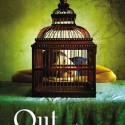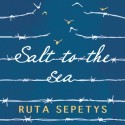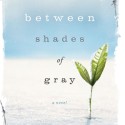An Interview with Ruta Sepetys – transcript
Don’t forget to read our review of Out of the Easy!
The following is a transcript of the interview with Between Shades of Gray and Out of the Easy author Ruta Sepetys. You can watch a cut version of the interview below or the full, half-hour length interview here. If you quote any of the interview, please credit us and provide a link either to this page or the YouTube video! Thanks.
Rhys: Can you just tell us a bit about Out of the easy before we start?
Ruta: Yes! Out of the Easy is set in New Orleans in 1950, and it follows the story of 17 year old Josie Morain who’s the daughter of a brothel prostitute. But despite the life she’s born into, she aspires to more, she wants to go to college, and specifically she wants to go to Smiths, which is outside of New Orleans, so, you know, it’s a story of family, it’s a story of identity, and overcoming one’s circumstance.
Rhys: Out of the easy isn’t as earth-shattering as between shades of grey in that it doesn’t deal with as complicated or important themes in a historical sense, so were you conscious of that and did that impact your search for a new story?
Ruta: No, I wasn’t conscious of that because although they’re both historical, to me they’re both intensely emotional, you know in Between Shades of Gray, you know, Lina is on a quest for freedom, but so is Josie, and so these are things that are intensely personal as these young girls are growing up and dealing with who and what they want to be and who they can become and so, no, both were these personal and certainly the history was different, you know, totalitarianism, dealing with totalitarianism in Between Shades of Gray, but no, I didn’t really consciously think of that, I chose to focus as I was writing more on the emotional truths in both of the stories rather than the historical truths.
Rhys: You’ve already said that both Lina and Josie share a sense of freedom, but you’ve also chosen to have two female protagonists in both your books. What made you make that decision and was it hard to distance yourself from Lina’s narrative before writing Out of the Easy?
Ruta: Well people ask if Josie and Lina are, well, “they’re a part of you” – and no, I wish! These girls are super heroes, and so some writers, they do tend to write main characters that are closely related to their own personal traits, I don’t. I think I write that I wish I could become, characters I admire, with qualities I wish I had and there are definitely similarities – they’re both stubborn, intelligent young women but coming from completely different backgrounds. Lina in Between Shades of Gray has a really supportive mother, a loving mother, Lina’s relationship to love and the idea of love is something very comfortable and something that comes very natural for her. On the other hand, Josie has no concept of love and in many cases feels probably that she’s unlovable. And so, I thought about that a lot whilst I was creating the character of Josie – what would it be like to learn to love and to learn to be loved, and considering the environment she’s growing up in, on the fringes of a brothel, she would most likely I imagine have trust issues, something that Lina probably wouldn’t have. So emotionally they were coming from very unique perspectives to that was easy for me to separate the two characters, I didn’t get muddled with that.
Rhys: You have in out of the easy, particularly, I think, you have a whole multitude of characters whose backstories are fantastic – it’s just so rich. How did you find your way into each and every one of those and create their individual worlds?
Ruta: Well the city of New Orleans was really conducive to creating this eccentric rich cast of characters, because the city itself is beautiful and tragic and complex at the same time and so the people that in interviewed, they ere so full of colour and flair, that it was easy to imagine and then set the book in a brothel and then automatically, when I did the research, the characters they were telling me were surrounding this brothel I thought well, “I have to have that… I have to have this person!”. I knew I had to have girls, and I knew I had to have a driver because all the people I interviewed said there were always drivers, so I knew I had to have a driver and I was sort of setting up these cast of characters, but once I started writing they all came to me so quickly, whereas in Between Shades of Gray, I actually, once I wrote the book, I had to go back and there were some characters that were similar and I had to define them more, whereas in out of the easy they were so crazy and unique in the first draft that I had to tone them back. The mother character, Louise, for example, I over wrote her. She was so evil and so awful and she was really fun to write but it was kind of ridiculous. So no, I love big casts of characters because I think, in our life, we are surrounded by a cast, and there’s a small group of people that we let into the inner circle, but sometimes it’s the people on the outside, in the fringes, that are more interesting, so I wanted to capture those people and how they would affect Josie as well.
Rhys: Was it easy to …you interview all these people, did you base any of their character traits on these people, when you were talking to them, maybe their dialogue/ways they speak?
Ruta: Well the character of Willie Woodley, the madam in Out of the Easy, she was based on Norma Wallace, and Norma was a notorious French quarter madam in the forties and fifties and I was so fortunate to be able to hear Norma’s voice; late in life, Norma thought “I need to capture my story” so she sat down with a tape recorder and probably a bottle of booze and started recording her life story. Well, a man in new Orleans had these cassette tapes, and he played some of them for me, so I actually got to hear her voice and hear how she described her business, how she ran her business, and you know, the gruffness in her voice, the toughness at certain points when she would speak about something there was this softness and this fondness that came out and that really helped to inform me of my character Willie Woodley, so that character was very much based on Norma, but the other characters were completely fictional and something that I just came up with out of my own imagination.
Rhys: So it’s set in New Orleans, when did you first get interested in writing about or setting a story in New Orleans?
Ruta: Well I’ve always been interested in New Orleans because there’s such diversity, and for a city in America, it’s a really unique American city. The music, the architecture, the food the superstitions make it so different than any other city in the united states so I had always been fascinated with it, and then for my birthday one year someone gave me this pair of opera glasses, and they were still in the original vintage case and when I opened up the case it still had the jeweller’s name in no and all the original papers and they were engraved and dated from someone named Willie Robert, so I thought, “oh wow I’ve got the full name” so I can probably find out from the census of who this person was, so I enlisted the help of a librarian in New Orleans to help me trace the origin of these glasses, and she was interested in the hunt too, so she did some research and got back to me and said”, Willie is not a man, Willie is a woman!” and I think, she may have been a madam in the French quarter. Well, there was no may have, for me, this was “oh no! I have a madam’s opera glasses, I have a hookers opera glasses! You know, this is a brothel, I love it” so I became really intrigued but then she said, “wait, there’s more; the jeweller that sold Willie the glasses, he was poisoned!” and I thought, “oh my gosh, there’s brothels, and madams and gangsters and people poisoned” and you know. And as I was reading news stories from the time period, each newspaper had dozes of articles that could each be stories themselves and it’s just a fascinating and complex city and the perfect place to set a novel and that’s why I chose new Orleans.
Rhys: With Out of the Easy, unlike Between Shades of Gray, you’ve got a certain amount of objectivity because obviously in Between Shades of Gray your heritage links you directly to Lina’s story. How did that affect your writing?
Ruta: How did it affect writing out of the easy?
Rhys: Yeah, the objectivity of it.
Ruta: Well, because I wasn’t as coloured by personal emotions and personal grief. This was something that was completely fictional where when I was writing Between Shades of Gray I knew this had happened and I knew that some of the things I was writing about had actually happened to my family members and in Between Shades of Gray writing a story knowing that my freedom and all the liberties that I enjoy came at the expense of my family members, that was such a heavy burden to bear as I was writing and I so wanted to honour the people who had experienced this, whereas writing out of the ask I came at it more, more than historical more in an emotional way; it was an emotional story I wanted to tell, an emotional story of emotional coming of age, emotional healing, so I was able to remain more objective also because there weren’t certain threads that I had to stick to. In Between Shades of Gray I had interviewed survivors and there were things that we had agreed to put in the book so I had to put them in the book but in out of the easy I didn’t have to put anything, I didn’t have to put anything in the book so I could pick and choose what I thought was really the best from the people I interviewed r even just my imagination. So for me that was a lot more fun.
Rhys: Just coming back to having to put stuff in the book: was that part of a contract that you’d had with these Lithuanians that you’d include certain historical accuracies that they wanted portrayed?
Ruta: No, not so much they were very hesitant when I was interviewing them to ask me to put anything in the book. However, if half a dozen people told me the same thing and the way they told me, holding my hands and saying “this is what happened, and the world has forgotten us”, I could tell it was something so important so I wanted to put it in the book, the way they suffered in the train car, the way their relatives, the way they reminisced about holidays and things like that, I know it was important to them personally, so I put it in the book. So maybe it was just an unspoken contract, if you will, whereas here I didn’t have any unspoken contracts with hookers or gangsters so it was a lot easier!
Rhys: Is there anything you’d did differently whilst writing Out of the Easy than you did writing Between Shades of Gray?
Ruta: Yes, as I was writing Between Shades of Gray, I was doing the research at the same time. I thought he best way to capture the story was to write it as I was researching it, that it would have a sense of immediacy, and I found that really caused me a lot of problems because there was such an emotional intensity; the book was way too dark and I had to go back and rewrite it so many times and the original Between Shades of Gray and what it became as the published novel is so drastically different whereas with out of the easy I did the research and I got a sense of what I was going to put in the novel and then I wrote it, and it was a much faster process and I didn’t have to revise nearly as much and the things I did, they were more historical for out of the easy than emotional content that I had to revise.
Rhys: Both your novels are historical fiction, is there any chance of you straying away from the genre?
Ruta: You know, I love historical fiction so much, and someone asked me recently, “so your books – they’re a search for history?” and I said, although I write, you know, search for history, it’s also a search for story and I think that history can be boring but through characters, you know, and a certain story line, suddenly these statistics, they become human, and suddenly we care for people we have never met and suddenly history becomes important. We know the dates, we know the place on the map, and that’s the power of books, and so as an author, I guess I feel that through historical fiction I have an opportunity to give readers not only books they like but books they need, books to heal hearts and books to heal history, and also through historical fiction I have a chance to reveal hidden heroes. You know, we tend to put people on a pedestal, celebrities, musicians the cult of personality, and in many cases these people aren’t heroes at all and the hero is the quiet soul you know, that was never a celebrity and so if I can bring those every day heroes , real heroes to life, that’s something that I love doing; history holds secrets and writing historical is a bit like being a detective, so for now, I’m sticking with it, I mean I’m too old, I know better than to say always or never, I know, but I love historical, but I’m so grateful that there are so many authors now like Libbra Bray, who’s doing historical in a completely new and unique way or books like code name verity that are really pulling readers to historical fiction. I’m certainly not a lone and there are a lot of people that are doing it better than I am, so I’m still motivated!
Rhys: Do you think you’ll be sticking to the 20th century or…
Ruta: No! No, absolutely not, I think that’s the thing about history, I mean there are so many amazing stories; I have a list as long as my arm of things I’d like to write about. There are so many stories out there; I’m not sure on material, just short on time!
Rhys: So what’s next?
Ruta: What’s next? Well, I’m going back to world war 2, and I am writing a very little known story but one that I am super excited about, and it takes place at the end of ww2, when the Germans were fleeing from the soviets, and it takes place in east Prussia and as the soviets were pushing in the Germans were staging this large naval evacuation and they commandeered every boat and every ship imaginable to get the Germans out of east Prussia, and they commandeered this ship, the Wilhelm Gustave, and it was a cruise ship and it hadn’t sailed for several years and they put the German soldiers aboard and realised they had more room – the ship held about 1500 people – so they decided to take some refugees, and there were refugees in the area from Lithuania, from Latvia, Estonia, there were ethnic Germans that were fleeing, east Prussians, some polish people. So many people wanted to get on the boat. Well, the boat held 1500, but when it sailed it had 10,000 people on it, and it had to sail in deep water because it had so much wait and they sailed in the dead of night with all of the lights off because they didn’t want to be seen by a soviet plane. Well a soviet submarine saw the boat and it torpedoed the ship and it sank in 45 minutes and 9000 people drowned. It’s 9 times the size of the Titanic and the world knows nothing of it because the Nazis hid the story. And people think “that was a German boat”, the boat was full of refugees, full of innocent teenagers, because imagine, the men were gone, and women and children; women could bring one child but in many cases they had more than one child so they had to choose who to send, so they would send the teenagers, so the boat was full of teens and all of these fates converged on board this ship. So the book follows four different teenagers, and they come together and board this ship. And it’s not a cruise for leisure; it’s a cruise for life. And I’m writing that right now. And talk about something intensely emotional; I was able to go to there where the ship sank and meet with the divers, the original divers, who dove the wreck, and they were told to go down because the Nazis were notorious for plundering art and valuables and the ship was stuffed full of art and treasure, and these men were told to go down and retrieve this treasure not knowing there were 9000 people, and how it affected their lives and changed them, so, you know, every step of the way of this has been so emotional and some of the characters from Between Shades of Gray will resurface in this book
Rhys: So it’s a sequel of sorts?
Ruta: It’s a continuation, it’s a thread, there is a thread from Between Shades of Gray that continues in this new book and I’m so enjoying writing, and my family laughs and says, why do you do this to yourself because I’ll finish the day writing and I’ll be a wreck, I’ll be crying and in tears, but I’m passionate about it, there were so many people that were affected by this and so few that survived and the world knows nothing of it, so…
Rhys: I’m just gonna jump back to out of the easy because I missed a question. When we were emailing, after I had read out of the easy, we spoke about Patrick, so this might be a bit of a spoilery question but, can you tell us more about him and how he came to his sexuality and how that kind of developed. And I know kitty is based on a friend’s mother?
Ruta: Well, when I was researching the time period of 1950 and the 50s in general, I had this preconceived notion that it was this time of perfection and happiness, but it wasn’t. it was really a time of secrecy and pain, and the more I researched the more my heart was breaking for these people; men had gone off to war and come back, and were dealing with these emotional traumas but It wasn’t socially acceptable in then to admit that you were full of pain or that you needed help. So they were suffering. Women had been recruited into the work force during ww2 with these images of rosy deriviter to serve their country and they reluctantly went off to work and then realised, “I enjoy this2, but when the men came back they had to surrender their jobs so the women were disgruntled. So we had men who were disgruntled, women who were disgruntled….if someone were ill in your family, you weren’t to talk about it. That was the mark against a family if someone were sick. And this was all so painful to me, and as I was interviewing people, they were sharing secrets about themselves and the pain they were in at the time, trying to keep up this façade and one that I kept coming back to was this issue of sexuality, and how, I mean more than someone being sick or more than someone being depressed, this was something that was never spoken of and that they themselves, you know, they themselves were trying to change and hide and felt they were born into this brokenness and some sort of deviance and it was just heart-breaking for me, and so I thought of this character, you know we have Josie moraine on the one hand who feels like she’s born into an identity she can’t change, and then I thought well Josie feels that everyone judges her, that her mother is a prostitute and this is the French quarter of new Orleans which is very small, and she thinks it’s so unfair that people judge her, and misjudge her and they think you know, that they know who she is, when in reality, she has misjudged her very best friend. And even she has blinders on, because of the time period, and the type of family Patrick comes from, it’s not even in her consciousness. So I thought of this character, who has this best friend, and he’s desperately trying to communicate to her. And she’s missing it. And she’s missing the point. And then women who were with men and married men not knowing you know, that they were gay because the men themselves weren’t honest, they couldn’t be honest about their sexual identity, and the pain that that caused on so many fronts and so I didn’t want it to become the main focus of the novel but it was something that broke my heart into so many pieces that I wanted to weave it in, you know, and I did that through Patrick who’s suffering on many levels, with his father, and his father is this writer who is in early stages of Alzheimer’s, which is undiagnosed, they simply think he’s losing his mind, and so there’s this complexity that Patrick is struggling with not only telling his friends but being honest with himself and who he is. And I am so happy and grateful that we have come so far, I know we still have a long way to go, but that we ‘ve come so far that these things don’t have to be a secret and I sort of wanted to encompass that through a couple of things in the story; the Siamese acorns; this is how these acorns came into the world, you know, and some people could say, “oh, that’s some sort of mutation”, and no, they’re beautiful, that’s how they came into the world, and when Patrick is discovering his father’s book and they’re trying to discover what the chapter names are, and he realises that it’s called “be love” and that his father was trying to send a message to his son saying “I know” and what’s more important is the capacity to love another human being. It doesn’t matter if it’s a woman loving another woman or a woman loving a man….the important thing is being able to love, and that’s something that Josie’s struggling with herself; her best friend has a capacity to love but she doesn’t understand the situation that he’s going through. And that’s my long winded answer but I hope you can tell that I was so passionate about this, and I’m so passionate about it when readers get it – and you got it right away, and maybe I made it a little bit too vague, but I didn’t want it to take over the novel, but it was definitely a complexity of the time period that so many people I interviewed brought up, so I thought, to really be authentic I’m gonna put this in!
Rhys: It’s very heart-breaking in the novel – you had me almost in tears! Do you think you’ll return to Patrick’s story at some point?
Ruta: I would love to, I would love to.
Rhys: Because, at the end of the novel he leaves, of course, and so you’ve got an entire…
Ruta: Here is someone that Josie feels she has to physically take herself out of new Orleans in order to have a chance at life, and her best friend feels the same for different reasons. There are so many things that are similar in their stories, yet they can’t verbalise this, and they can’t talk to one another about it, but they both physically feel they need to leave new Orleans, and he goes off to the west indies where maybe, he won’t be under the watchful eye of these judgemental neighbours and people in uptown society, and she feels she has to go off to north Hampton, where people don’t know her and the identity she was born into , she can make a new one for herself. So yes, I’d still like to explore Patrick’s story and I have a million ideas for it!
Rhys: Ok, thank you very much!
Ruta: Thanks so much!







What did you think about An Interview with Ruta Sepetys – transcript?